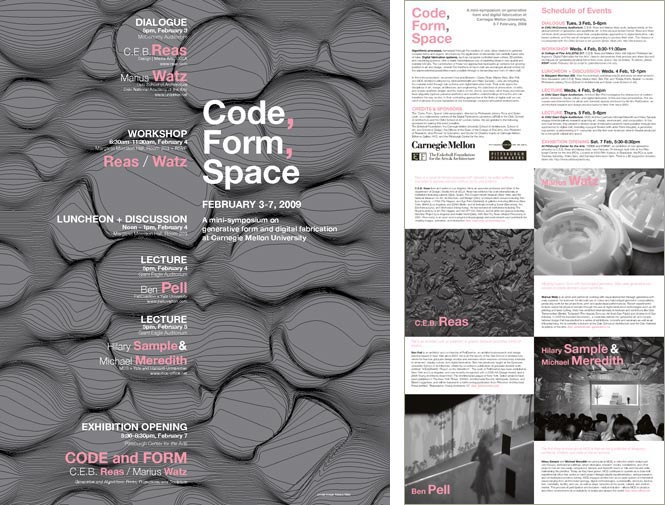Printed from www.flong.com
Contents © 2020 Golan Levin and Collaborators
Golan Levin and Collaborators
Projects
Sort by : Author | Date | Name | Type
- Installations
- Ghost Pole Propagator II
- Augmented Hand Series
- Eyeshine
- Re:FACE, Anchorage Version
- Merce's Isosurface
- Double-Taker (Snout)
- Opto-Isolator
- Eyecode
- Interstitial Fragment Processor
- Reface [Portrait Sequencer]
- Ghost Pole Propagator
- Footfalls
- Scrapple (Installation)
- The Manual Input Workstation
- Interactive Bar Tables
- Messa di Voce (Installation)
- Hidden Worlds of Noise and Voice
- Re:MARK
- Introspection Machine
- Audiovisual Environment Suite
- Dakadaka
- Rouen Revisited
- Performances
- Ursonography
- Scrapple (Performance)
- The Manual Input Sessions
- Messa di Voce (Performance)
- Dialtones (A Telesymphony)
- Scribble
- Net.Artworks
- Terrapattern
- Moon Drawings
- Free Universal Construction Kit
- QR Codes for Digital Nomads
- The Dumpster
- Axis
- JJ (Empathic Network Visualization)
- The Secret Lives of Numbers
- Alphabet Synthesis Machine
- Obzok
- Sketches
- Stria
- Dendron
- Slamps
- Banded Clock
- Floccus
- Stripe
- Meshy
- Directrix
- Yellowtail
- Streamer
- Blebs
- Self-Adherence (for Written Images)
- Poster design for Maeda lecture
- The Role of Relative Velocity
- Segmentation and Symptom
- Floccular Portraits
- Curatorial
- Mobile Art && Code
- ART AND CODE
- Code, Form, Space
- IEEE InfoVis 2008 Art Exhibition
- Solo exhibition at bitforms gallery
- IEEE InfoVis 2007 Art Exhibition
- Signal Operators
- Commercial / Industrial
- Motion Traces [A1 Corridor]
- Civic Exchange Prototype
- Amore Pacific Display
- Interactive Logographs
- Interval Projects
- Media Streams Icons
- Miscellaneous
- NeoLucida
- Rectified Flowers
- GML Experiments
- New Year Cards
- Admitulator
- Glharf (or Glarf)
- Finger Spies
Code, Form, Space
2009 | Co-organized by Jeremy Ficca and Golan Levin
Code, Form, Space was an interdisciplinary mini-symposium about generative form and digital fabrication, held at Carnegie Mellon University during the week of February 3-7, 2009. The weeklong event series represented a collaborative venture between the Digital Fabrication Laboratory (dFAB) in the CMU School of Architecture and the CMU School of Art Lecture Series, and included an exhibition of generative art at the Pittsburgh Center for the Arts.
Statement
Algorithmic processes, harnessed through the medium of code, allow creators to generate complex forms and organic structures by the application of elementary but carefully-tuned sets of rules. Digital fabrication systems, such as computer-controlled laser cutters, 3D printers, and machining systems, offer a nearly instantaneous way of exploring ideas in new spatial and material formats. The combination of these two approaches represents an extreme but growing position in art and design, wherein the traditions of hand-craft are exchanged almost entirely for the unprecedented possibilities made possible through a demanding new form of mind-craft.
In this mini-symposium, we present four practitioners C.E.B. Reas, Marius Watz, Ben Pell, andMOS Architects (directed by Michael Meredith and Hilary Sample) who are refiguring the material world through rule systems and digital fabrication tools. Their work spans the disciplines of art, design, architecture, and engineering; the objectives of provocation, of utility, and of pure aesthetic delight; and the realms of bits, atoms, and ideas. All of these practitioners have singularly rigorous personal aesthetics and sensitive understandings of how the arts can transform the way we live. In their contrasting approaches at the limits of digital craft we can catch a glimpse of a new humanism in our increasingly computer-articulated environments.
The Code, Form, Space mini-symposium featured lecture presentations, a workshop, a roundtable panel discussion and luncheon, visiting critiques, a display of student assignments, and a gallery exhibition of presenter artworks at the Pittsburgh Center for the Arts.

 (Above: Generative artworks by Casey Reas and Marius Watz at the Pittsburgh Center for the Arts, April 2009.)
(Above: Generative artworks by Casey Reas and Marius Watz at the Pittsburgh Center for the Arts, April 2009.)
Credits & Sponsors
The Code, Form, Space mini-symposium, co-directed by Professors Jeremy Ficca and Golan Levin, is a collaborative venture of the Digital Fabrication Laboratory (dFAB) in the CMU School of Architecture and the CMU School of Art Lecture Series. We are grateful to the following sponsors for making this event possible: The Enkeboll Foundation; the Carnegie Mellon University School of Architecture, School of Art, and School of Design; the Offices of the Dean of the College of Fine Arts, Vice President of Research, Vice-Provost for Education, and STUDIO for Creative Inquiry at Carnegie Mellon; bitforms gallery, NYC; and the Pittsburgh Center for the Arts.
Additional Thanks
The organizers and presenters of Code, Form, Space also thank the following individuals for their assistance in realizing the event and exhibition: P. Zach Ali and the student assistants of the CMU School of Architecture Digital Fabrication Laboratory (dFab); Courtney Dow, Fran Flaherty, Lauren Goshinski, Terry Hritz, David Calman Lasky, Michael Pisano, and Wayne Savage, of the CMU School of Art; Laura Blereau of bitforms gallery, NYC; and Laura Domencic, Stefanie Moser, and Adam Welch of the Pittsburgh Center for the Arts.
Keywords
Computational form, generative form, digital fabrication, rapid prototyping, conference, symposium, lecture, presentation, exhibition, C.E.B. Reas, Casey Reas, Marius Watz, Ben Pell, Michael Meredith, Hilary Sample, MOS Architects, PellOverton, art, design, architecture, computation, Golan Levin, Jeremy Ficca, Carnegie Mellon University, CMU.
Additional Resources
Code, Form, Space is represented by official web pages at the CMU School of Architecture and at the CMU School of Art Lecture Series web sites. A PDF poster and brochure for Code, Form, Space can be downloaded here. High-resolution images from the conference and exhibition can be found in this Flickr photoset.




